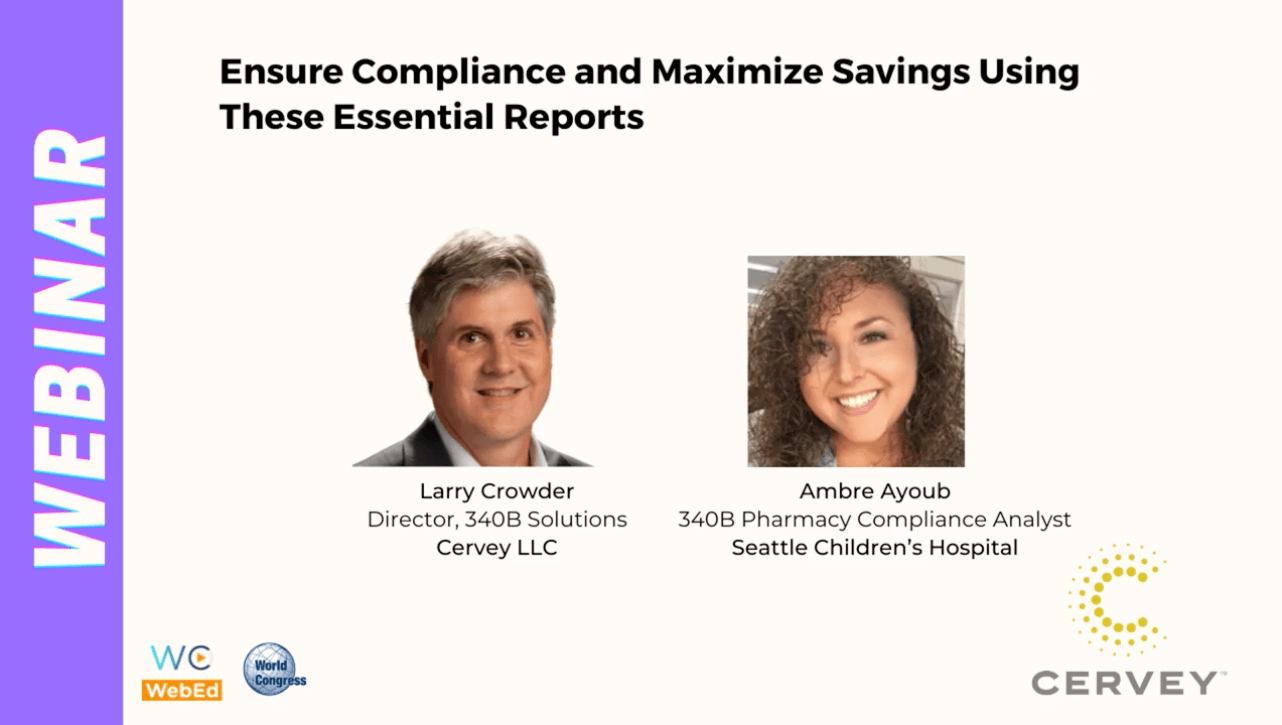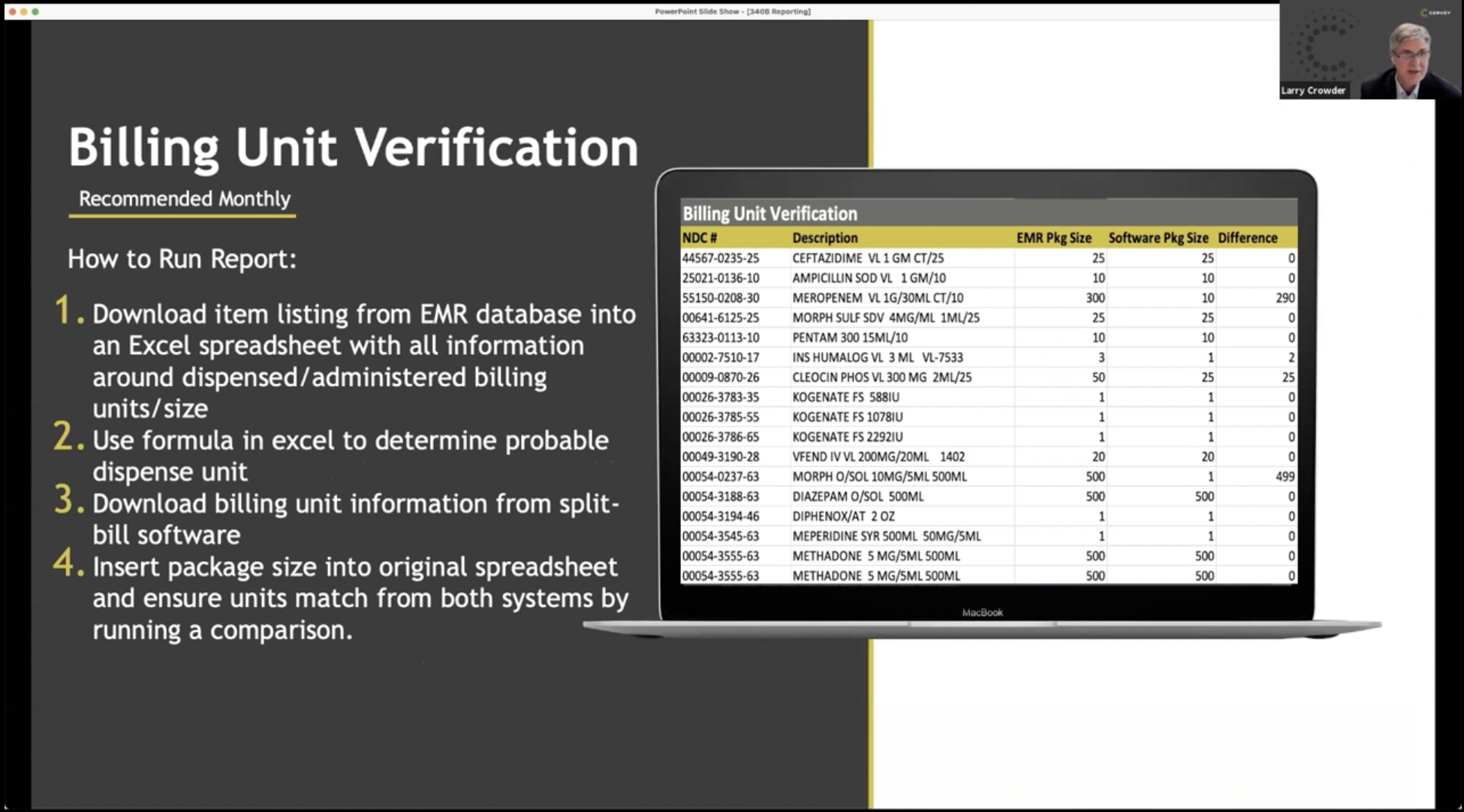
Modern Healthcare Technology Blog

340B Webinar Series - 340B Compliance & Savings: Part 5
In Part 5 of the 340B Webinar Series - 5 Reports to Ensure 340B Compliance and Maximize Savings Larry Crowder, VP of Cervey and Ambre Ayoub, 340B pharmacy compliance analyst with Seattle Children's Hospital are going to cover the last of the five 340B reports, the Billing Unit Verification Report. These five reports are to ensure compliance, maximize savings in the 340B program.
Missed parts 1 through 4? You can find more info below:
- Part 1: NDC or Code Mismatch Report
- Part 2: WAC Impact Report (DSH/PED)
- Part 3: Missed 340B Savings Report
- Part 4: 340B Variance Report

340B Webinar Series - 5 Reports to Ensure 340B Compliance and Maximize Savings: Part 5
Larry Crowder:
We will go through these five reports that are the most helpful or benefit you the most in being efficient with your program. Then Ambre is to go over how Seattle Children's Hospital implements these reports.
Billing Unit Verification Report
Larry Crowder:
Billing unit verification. So this is a big topic. And we say this to all the covered entities. You all have different TPAs, and some TPAs have various tools for billing units than others.
But again, just as we stated before, don't count on your TPA to automatically come up with the perfect billing unit for you using your EMR data. It's always the best practice and policy to go through and check and put your eyeballs on each billing unit.
So that's very time-consuming. And we know people with resources being short don't like that. But if you go through and put your eyeballs on all the billing units, especially your liquids and injectables, because obviously, tabs and caps are pretty good. But your liquids and injectables can be off.
If that configuration within your software is off, your billing unit is off, and you're just not aware of it without checking it. So there are different software, and some of them have like little flags that'll say, yes, I've checked this billing unit, and a red flag means no, we haven't checked the billing unit. So definitely use the tools there for you to use, and check those billing units. And if you need to do it manually, again, every report here, I'm trying to allow you to do it yourself even if you don't have access to a report with your TPA.

How to Run the Billing Unit Verification Report
Larry Crowder:
We recommend that you run this report monthly.
Essentially you're going to want to download your database from your EMR system. So if you have a data geek in your facility, data geeks love doing this kind of stuff where you can download from the EMR and account for J codes. You can account for the unit billing or however you're doing it. However, your data's coming across and get a package size that you think would be accurate and then go to your TPA software and compare it, and see if it's the same thing.
Another way of doing it is with dispenses coming across; see what the average dispense is. Again, we just talked about the Variance Report (Packages Accumulated vs. Packages Purchased) does the same thing. Still, you can see and make sure that your average dispense is not like several packages. If your TPA sees it as several packages, there's a billing unit issue there.
You mentioned this a second ago, Ambre, but you do this with random selected-item(s) that come in on invoices. So when something comes in on an invoice, you might choose a random item and go back and verify the billing unit and that Seattle Children's Hospital deducted the proper amount with that billing unit and the software. Is that correct?
Ambre Ayoub:
Yes, we do that every month.
How Often to Run the Billing Unit Verification Report?
Larry Crowder:
So how often do you do this kind of report? Is it monthly?
Ambre Ayoub:
So for billing unit verification, this one is daily for us. And, again, we're lucky enough to have our TPA that I could get to see a new product that was processed that has a red flag because I hadn't validated yet. So we do this daily. And I think that the most sense anyway, just because if you want to accumulate and depend on the product and how often your entity uses it.
So our wholesaler fees our TPA, and that's not necessarily always right. So what you had said, be very vigilant about paying attention to the package sizes.
This morning I had one; it was lidocaine, it comes with ten vials, but the package size that fed into our TPA was one vial. So I had to update it. I also think that it's essential for us to utilize outside tools. For example, I use DailyMed when trying to validate an NDC. If I want to check, okay, what does ABC have? Let's make sure DailyMed says it's ten vials as well.
Larry Crowder:
Great. So, billing unit verification. Do not count on any software to tell you the right billing unit. You want to double-check that yourself and be on that. And once you get this going, you can turn it into any new items that come across each day. Those are the only items I have to check. So Ambre does it daily. She finds the new things every day, but even if you did it weekly, it would be a big step up to verify any new items that came across the TPA software this week. So I'm just going to check and make sure those billing units are correct regardless of whether they think that they put in the right one or not.
340B for Covered Entities and Manufacturers Webinar Poll
Larry Crowder:
So we have our second poll question. Again, answers are a single choice.
2. Which of the following reports has your facility used to track the accuracy and compliance of your 340B data?
- Variance Report (Acc vs. Pur)
- Billing Unit Verification
- All of the Above
- None of the Above
It's the same question, but now it's regarding the variance report and the billing unit verification. So I'm curious about how many of you are using the variance report, the accumulated packages versus purchase packages, and how many of you are validating your billing units manually outside of your software. Then, who's all the above and who's none of the above.
Results from the Webinar Participants
Here are the poll results from those who participated in the 340B for Covered Entities and Manufacturers Webinar.
1. Which of the following reports has your facility used to track the accuracy and compliance of your 340B data?
- Variance Report (Acc vs. Pur) - 8%
- Billing Unit Verification - 17%
- All of the Above - 33%
- None of the Above - 42%
So again, encourage you to look at those reports. Again, the variance report for those not running it can be an eye-opening report. That can help you capture things that may not be correct in your data in the software. So I highly encourage you to work on that.
Conclusion
Follow us to stay tuned for Part 6 of the 340B Webinar Series - 5 Reports to Ensure 340B Compliance and Maximize Savings here:
Contact Cervey for a demo of our 340B suite of web-based products that help 340B-eligible healthcare providers with three of their most pressing 340B needs: maximizing savings, ensuring compliance, and optimizing the performance of their contract pharmacies.
Looking for the rest of the webinar series? Check out parts 1-4 and 6-7 below:
- 340B Webinar Series - 5 Reports to Ensure 340B Compliance and Maximize Savings: Part 1
- 340B Webinar Series - 5 Reports to Ensure 340B Compliance and Maximize Savings: Part 2
- 340B Webinar Series - 5 Reports to Ensure 340B Compliance and Maximize Savings: Part 3
- 340B Webinar Series - 5 Reports to Ensure 340B Compliance and Maximize Savings: Part 4
- 340B Webinar Series - 5 Reports to Ensure 340B Compliance and Maximize Savings: Part 6
- 340B Webinar Series - 5 Reports to Ensure 340B Compliance and Maximize Savings: Part 7



